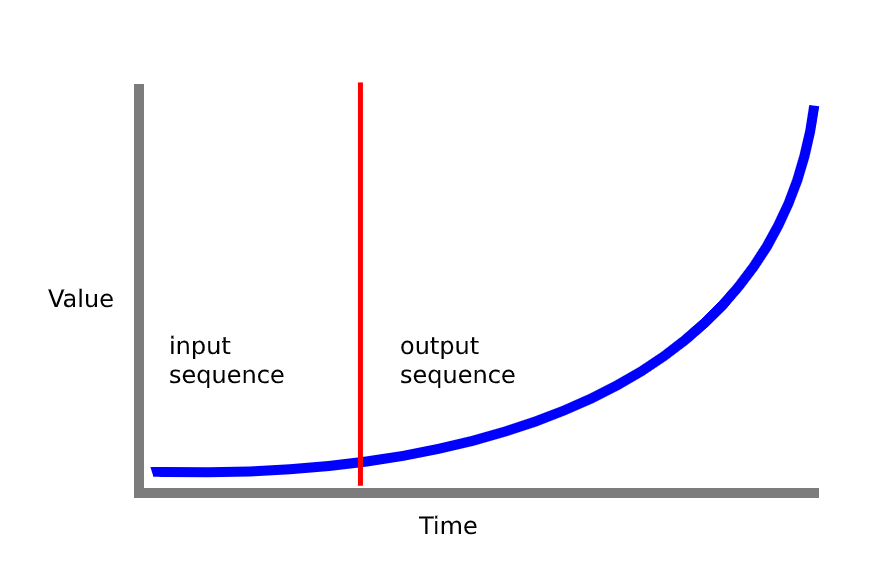I've tried to build a sequence to sequence model to predict a sensor signal over time based on its first few inputs (see figure below)

The model works OK, but I want to 'spice things up' and try to add an attention layer between the two LSTM layers.
Model code:
def train_model(x_train, y_train, n_units=32, n_steps=20, epochs=200,
n_steps_out=1):
filters = 250
kernel_size = 3
logdir = os.path.join(logs_base_dir, datetime.datetime.now().strftime("%Y%m%d-%H%M%S"))
tensorboard_callback = TensorBoard(log_dir=logdir, update_freq=1)
# get number of features from input data
n_features = x_train.shape[2]
# setup network
# (feel free to use other combination of layers and parameters here)
model = keras.models.Sequential()
model.add(keras.layers.LSTM(n_units, activation='relu',
return_sequences=True,
input_shape=(n_steps, n_features)))
model.add(keras.layers.LSTM(n_units, activation='relu'))
model.add(keras.layers.Dense(64, activation='relu'))
model.add(keras.layers.Dropout(0.5))
model.add(keras.layers.Dense(n_steps_out))
model.compile(optimizer='adam', loss='mse', metrics=['mse'])
# train network
history = model.fit(x_train, y_train, epochs=epochs,
validation_split=0.1, verbose=1, callbacks=[tensorboard_callback])
return model, history
I've looked at the documentation but I'm a bit lost. Any help adding the attention layer or comments on the current model would be appreciated
Update: After Googeling around, I'm starting to think I got it all wrong and I rewrote my code.
I'm trying to migrate a seq2seq model that I've found in this GitHub repository. In the repository code the problem demonstrated is predicting a randomly generated sine wave baed on some early samples.
I have a similar problem, and I'm trying to change the code to fit my needs.
Differences:
- My training data shape is (439, 5, 20) 439 different signals, 5 time steps each with 20 features
- I'm not using
fit_generatorwhen fitting my data
Hyper Params:
layers = [35, 35] # Number of hidden neuros in each layer of the encoder and decoder
learning_rate = 0.01
decay = 0 # Learning rate decay
optimiser = keras.optimizers.Adam(lr=learning_rate, decay=decay) # Other possible optimiser "sgd" (Stochastic Gradient Descent)
num_input_features = train_x.shape[2] # The dimensionality of the input at each time step. In this case a 1D signal.
num_output_features = 1 # The dimensionality of the output at each time step. In this case a 1D signal.
# There is no reason for the input sequence to be of same dimension as the ouput sequence.
# For instance, using 3 input signals: consumer confidence, inflation and house prices to predict the future house prices.
loss = "mse" # Other loss functions are possible, see Keras documentation.
# Regularisation isn't really needed for this application
lambda_regulariser = 0.000001 # Will not be used if regulariser is None
regulariser = None # Possible regulariser: keras.regularizers.l2(lambda_regulariser)
batch_size = 128
steps_per_epoch = 200 # batch_size * steps_per_epoch = total number of training examples
epochs = 100
input_sequence_length = n_steps # Length of the sequence used by the encoder
target_sequence_length = 31 - n_steps # Length of the sequence predicted by the decoder
num_steps_to_predict = 20 # Length to use when testing the model
Encoder code:
# Define an input sequence.
encoder_inputs = keras.layers.Input(shape=(None, num_input_features), name='encoder_input')
# Create a list of RNN Cells, these are then concatenated into a single layer
# with the RNN layer.
encoder_cells = []
for hidden_neurons in layers:
encoder_cells.append(keras.layers.GRUCell(hidden_neurons,
kernel_regularizer=regulariser,
recurrent_regularizer=regulariser,
bias_regularizer=regulariser))
encoder = keras.layers.RNN(encoder_cells, return_state=True, name='encoder_layer')
encoder_outputs_and_states = encoder(encoder_inputs)
# Discard encoder outputs and only keep the states.
# The outputs are of no interest to us, the encoder's
# job is to create a state describing the input sequence.
encoder_states = encoder_outputs_and_states[1:]
Decoder code:
# The decoder input will be set to zero (see random_sine function of the utils module).
# Do not worry about the input size being 1, I will explain that in the next cell.
decoder_inputs = keras.layers.Input(shape=(None, 20), name='decoder_input')
decoder_cells = []
for hidden_neurons in layers:
decoder_cells.append(keras.layers.GRUCell(hidden_neurons,
kernel_regularizer=regulariser,
recurrent_regularizer=regulariser,
bias_regularizer=regulariser))
decoder = keras.layers.RNN(decoder_cells, return_sequences=True, return_state=True, name='decoder_layer')
# Set the initial state of the decoder to be the ouput state of the encoder.
# This is the fundamental part of the encoder-decoder.
decoder_outputs_and_states = decoder(decoder_inputs, initial_state=encoder_states)
# Only select the output of the decoder (not the states)
decoder_outputs = decoder_outputs_and_states[0]
# Apply a dense layer with linear activation to set output to correct dimension
# and scale (tanh is default activation for GRU in Keras, our output sine function can be larger then 1)
decoder_dense = keras.layers.Dense(num_output_features,
activation='linear',
kernel_regularizer=regulariser,
bias_regularizer=regulariser)
decoder_outputs = decoder_dense(decoder_outputs)
Model Summary:
model = keras.models.Model(inputs=[encoder_inputs, decoder_inputs],
outputs=decoder_outputs)
model.compile(optimizer=optimiser, loss=loss)
model.summary()
Layer (type) Output Shape Param # Connected to
==================================================================================================
encoder_input (InputLayer) (None, None, 20) 0
__________________________________________________________________________________________________
decoder_input (InputLayer) (None, None, 20) 0
__________________________________________________________________________________________________
encoder_layer (RNN) [(None, 35), (None, 13335 encoder_input[0][0]
__________________________________________________________________________________________________
decoder_layer (RNN) [(None, None, 35), ( 13335 decoder_input[0][0]
encoder_layer[0][1]
encoder_layer[0][2]
__________________________________________________________________________________________________
dense_5 (Dense) (None, None, 1) 36 decoder_layer[0][0]
==================================================================================================
Total params: 26,706
Trainable params: 26,706
Non-trainable params: 0
__________________________________________________________________________________________________
When trying to fit the model:
history = model.fit([train_x, decoder_inputs],train_y, epochs=epochs,
validation_split=0.3, verbose=1)
I get the following error:
When feeding symbolic tensors to a model, we expect the tensors to have a static batch size. Got tensor with shape: (None, None, 20)
What am I doing wrong?
